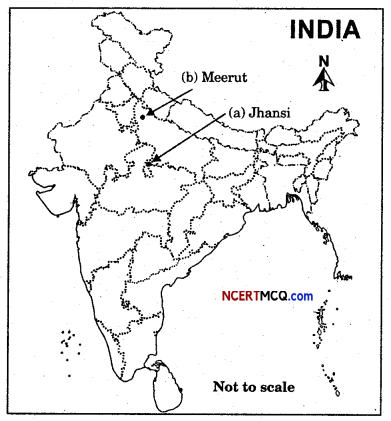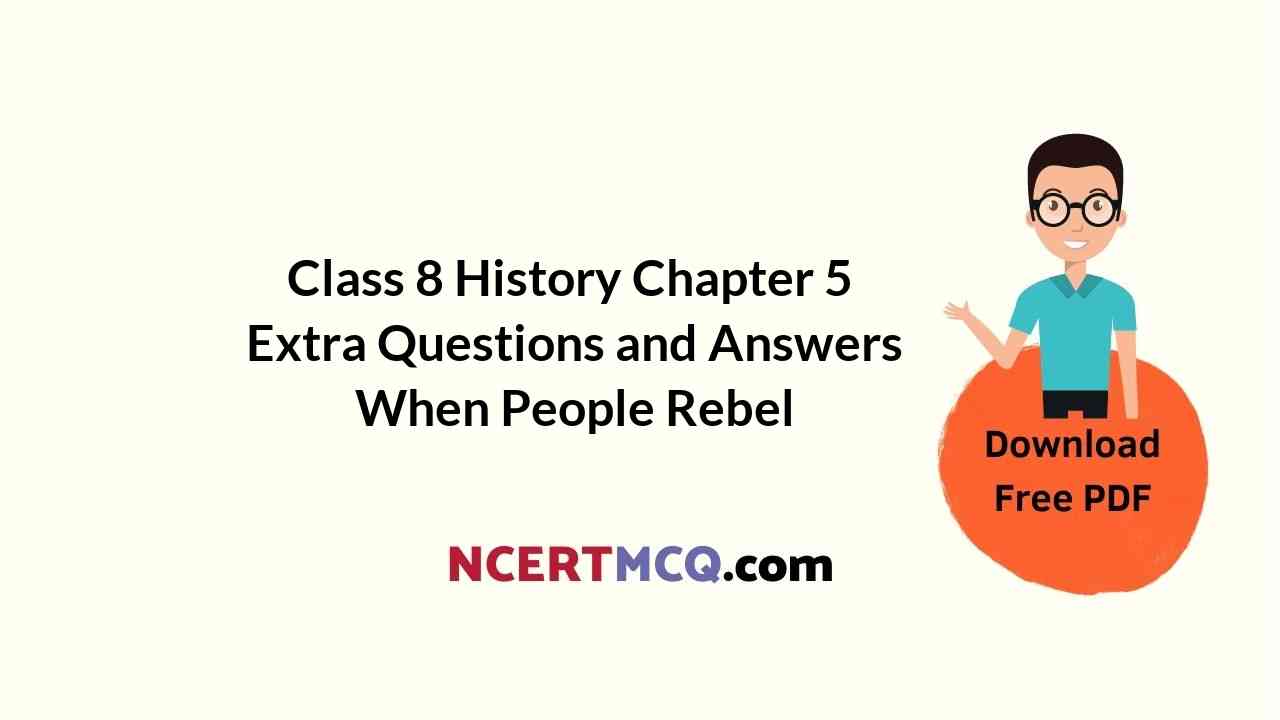Here we are providing Online Education for Class 8 History Chapter 5 Extra Questions and Answers When People Rebel was designed by subject expert teachers. https://ncertmcq.com/class-8-history-chapter-5-extra-questions/
Online Education for When People Rebel Class 8 Extra Questions History Chapter 5
Question 1.
When was the subsidiary alliance imposed on Awadh?
Answer:
In 1801.
Question 2.
When was Awadh annexed?
Answer:
In 1856.
Question 3.
On what ground was Awadh annexed.
Answer:
It was said that the territory was misgoverned and the British rule was needed to ensure proper administration.
Question 4.
Why were the sepoys reluctant to serve overseas?
Answer:
This was because, those days many people in the country believed that if they crossed the sea, they would lose their religion and caste.
Question 5.
Why did the sepoy refused to go to Burma in 1824?
Answer:
Due to fear of losing their religion and caste by travelling through the sea route.
![]()
Question 6.
When was a new law passed, if required, sepoy had to serve overseas?
Answer:
In 1856.
Question 7.
What was the impact of the British land policies, on the sepoy?
Answer:
The sepoys were angry because many of them were peasants and had families in the villages.
Question 8.
When did the sepoy mutiny start?
Answer:
In May 1857.
Question 9.
From where did the sepoy mutiny begin?
Answer:
From Meerut.
Question 10.
Who was Mangal Pandey? Why is he famous?
Answer:
Mangal Pandey was a sepoy in the Company army. He rebelled against the British and was hanged.
Question 11.
Who was Nana Saheb?
Answer:
Nana Saheb was the adopted son of the late Peshwa Baji fear.
Question 12.
Who was Tantia Tope?
Answer:
He was the general of Nana Saheb.
Question 13.
Below are given the names of some rebel leaders. Name the places where they headed the rebellion. Ahmadullah Khan, Kunwar Singh, Bakht Khan.
Answer:
Ahmadullah Khan – Lucknow Kunwar Singh – Bihar Bakht Khan – Delhi.
Question 14.
When was Delhi recaptured from the rebel forces.
Answer:
In September 1857.
![]()
Question 15.
Which rebel leader fought a ‘guerilla war with the British?
Answer:
Tantia Tope.
Question 16.
What reward was announced for the loyal landlords?
Answer:
They were allowed to continue to enjoy traditional rights over their lands.
Question 17.
When was the power from the hands of the East India Company transferred to the British Crown?
Answer:
In 1858.
Question 18.
What was the Governor-General called from 1858?
Answer:
Viceroy.
Question 19.
What major change was observed in ruling Indian territory after the revolt of 1857?
Answer:
After the revolt of 1857, the British Government undertook direct responsibility for ruling India.
Question 20.
Why were Muslims treated as hostile after 1857?
Answer:
This was because the British believed that they were responsible for the rebellion in a big way.
Question 21.
What plan did the company make to bring an end to the Mughal dynasty?
Answer:
- In 1849, Dalhousie announced that after the death of Bahadur Shah, the family of the king will have to leave the Red Fort.
- In 1856, Canning decided that Bahadur Shah Zafar would be the last king. After his death none of his descendants would be recognised as king.
Question 22.
Why were the sepoys employed in the service of the Company unhappy?
Answer:
- Most of the sepoys were farmers and land policies of the Eptish harmed them.
- They were unhappy about their post, allowances and conditions of service.
- Also, some of the new rules violated their religious sensibilities and beliefs.
Question 23.
What new rule was passed about the overseas service of the sepoy in 1856?
Answer:
In 1856, the Company passed a new rule that every new person who would look for employment in the Company’s army had to agree to serve overseas if required.
![]()
Question 24.
How did the following react during 1857? Nana Saheb, Begum Hazrat Mahal.
Answer:
- Nana Saheb – He gathered armed forces and expelled the British garrison from Kanpur. He proclaimed himself Peshwa. He declared that he was a governor under emperor Bahadur Shah Zafar.
- Begum Hazrat Mahal – She was the wife of the deposed Nawab Wazid Ali Shah of Lucknow. She took an active part in organising the uprising against the British.
Question 25.
On the outline map of India, locate the following places :
(a) Jhansi
(b) Meerut
Answer:

Question 26.
What reforms were made by the British in the Indian society? How did Indians see these laws?
Answer:
1.
- Laws were passed to stop the practice of Sati and to encourage the remarriage of widows.
- English-language education was actively promoted.
- The Company allowed Christian missionaries to function freely in its domain and even own land and property.
- Laws were passed for easy conversion to Christianity. Those who converted to Christianity could now inherit ancestral property.
2. Many people felt that British were destroying their religions, social customs and traditional ways of life.
Multiple Choice Questions (MCQs)
1. Which of the following statements is not correct?
(a) The British did not recognise the adopted son of Rani Lakshmibai of Jhansi as the heir to the kingdom.
(b) Nana Saheb, the adopted son of Peshwa Baji Rao II, was denied his father’s pension.
(c) Awadh was annexed in 1856.
(d) The descendants of Bahadur Shah Zafar were recognised as kings.
Answer:
(d) The descendants of Bahadur Shah Zafar were recognised as kings.
2. A massive rebellion against the British started in May 1857. Sepoys mutinied in several places beginning from
(a) Delhi
(b) Meerut
(c) Lucknow
(d) Kanpur
Answer:
(b) Meerut.
![]()
3. Tick the wrong pair in the following.
(a) Mangal Pandey – Meerut
(b) Ahmadullah Shah – Faizabad
(c) Bakht Khan – Bareilly
(d) Kunwar Singh – Bihar.
Answer:
(a) Mangal Pandey – Meerut.
4. Which statement is not correct in the following?
(a) Bahadur Shah Zafar’s sons were shot dead by the British before his eyes.
(b) Ghazis were religious warriors who came together to wipe out the white people in the 1857 Revolt.
(c) Bahadur Shah Zafar died in Delhi in 1862.
(d) Begam Hazrat Mahal took an active part in organising the uprising against the British in Lucknow.
Answer:
(c) Bahadur Shah Zafar died in Delhi in 1862.
5. Which of the following towns were not the main centres of the 1857 Revolt?
(a) Meerut, Delhi
(b) Moradabad, Saharanpur
(c) Lucknow, Kanpur
(d) Jhansi, Bareilly
Answer:
(b) Moradabad, Saharanpur
6. Who was the last Mughal emperor?
(a) Akbar
(b) Aurangzeb
(c) Jahangir
(d) Bahadur Shah Zafar
Answer:
(d) Bahadur Shah Zafar.
Glossary:
→ Mutiny – When soldiers as a group disobey their officers in the army.
→ Firan gis – Foreigners. The term reflects an attitude of contempt.
